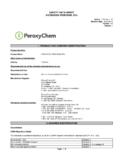Transcription of ANCSA at 35 Delivering on the Promise Proof 10 …
1 ANCSA at 35. Chapter 12. THE ALASKA NATIVE CLAIMS SETTLEMENT ACT AT 35: Delivering ON THE Promise . James D. Linxwiler Guess & Rudd Anchorage, Alaska Paper 12, 53rd Annual Rocky Mountain Mineral Law Institute, 2007. Synopsis Introduction Summary of ANCSA . Developments in ANCSA . [1] Alaska Native Claims of Aboriginal Title [a] History of Aboriginal Title to Alaska The Origin and Need for ANCSA . [i] Treaty of Cession [ii] Organic Act of 1884. [iii] Territorial Organic Act of 1912. [iv] Alaska Statehood Act [v] Statehood Act Selections and Conveyances [vi] Native Claims [vii] The Freeze and the Super Freeze [b] ANCSA 4 Extinguishment of Aboriginal Title [2] Provisions Relating to Native Corporation Structure [a] Section 7 Regional Corporations [b] Section 8 Village Corporations [c] Section 7(h) Restrictions on Alienation [d] Sections 5 and 7(g) Native Roll and Shareholders [e] Sections 6 and 9 The Alaska Native Fund [3] Section 7(i) and (j) Sharing Mineral Wealth Among Regional Corporations [a] ANCSA 7(i).
2 [b] ANCSA 7(j) Mandatory Payments by Regional Corporations to Village Corporations and At-Large Shareholders [4] Provisions Relating to Native Lands [a] Sections 11(a)(1) and 12(a) Village Withdrawals and Selections -1- [b] Regional Corporation Withdrawals and Selections [c] Section 14 Village and Regional Conveyances [d] Land Exchanges [e] Section 16 Southeastern Alaska Native Corporations [f] Indian Reservations [g] Provisions Relating to Third Party Rights [i] Valid Existing Rights [ii] Section 14(c) Reconveyances by Village Corporations [iii] Native Allotments [iv] Section 17(b) Easements [v] Section 21(j) Shareholder Homesites [vi] Section 14(f) Village Consent to Exploration and Development of Regional Subsurface [h] Alaska Land Transfer Acceleration Act [i] Title II. [ii] Title IV. [5] Securities Laws and Proxy Solicitations Achieving an Astonishing Economic Success Delivering on ANCSA 's Promise Conclusions Introduction 1.
3 The Alaska Native Claims Settlement Act ( ANCSA ), enacted in 1971, was an experiment in resolving aboriginal title in Alaska. In ANCSA , Congress sought to resolve claims of aboriginal title without resort to tribes, reservations, and 2. litigation. Instead, Congress created 13 for-profit regional corporations and 225 for- profit village corporations, and conveyed to them some 40 million acres of land, 1. Act of Dec. 18, 1971, Pub. L. No. 92-203, 85 Stat. 688, as amended, 43 1601-1629h (elec. 2007). 2. See ANCSA 2(b), 43 1601(b) (elec. 2007): Congress finds and declares that .. (b) the settlement should be accomplished .. without litigation .. [and] without establishing any permanent racially defined institutions, rights, privileges, or obligations, without creating a reservation system or lengthy wardship and trusteeship.. See also H.
4 Conf. Rep. 92-746, Dec. 13, 1971, 1971 2247, 2253: [T]he conference committee does not intend that lands granted to Natives under this Act be considered Indian reservation' lands for purposes other than those specified in this Act. The lands granted by this Act are not in trust' and the Native villages are not Indian reservations.' . Approximately four million additional acres were also conveyed under ANCSA 19, 43 1618 (elec. 2007), to former Indian reservations that chose not to accept the -2- 3. and $ million. ANCSA embodied a totally new approach to resolving aboriginal title claims, unlike any used anywhere before or since. ANCSA was driven in large part by the need to resolve aboriginal title claims that prevented the development of the North Slope oilfields and the Trans-Alaska Pipeline, and it was drafted from the beginning with profitable business activities and resource developments in mind, so it can be viewed as a unique response to the interaction of native peoples and mineral development.
5 ANCSA posed a compelling mix of statutory complexity, national policies, and the interests of Alaska Natives. While the initial approach embodied a considerable amount of idealism concerning the transformational power of capitalism, ANCSA . almost immediately embarked upon a course of extensive litigation and statutory amendments midcourse corrections required to adjust ANCSA to the real world. The result is a smoothly functioning statutory system of corporations administering assets for the Alaska Native community. However, the result also deviates somewhat from the original conception of ANCSA , and in certain ways more resembles traditional Indian policy, at least to the extent that ANCSA now seeks to preserve the ANCSA land base and corporate structure from economic forces to 4. ensure perpetual ownership by Natives. For example, undeveloped ANCSA lands 5.
6 Now cannot be taxed or taken in satisfaction of debts or in bankruptcy proceedings;. ANCSA stock, which was to be freely alienable after 20 years, now is not alienable unless a corporation so elects; and the one-time issuance of corporate shares can be augmented by issuance of shares to new shareholders (for instance, to those born benefits of ANCSA . 3. The large initial numbers of village corporations have decreased somewhat due to mergers and dissolution. As of December 2005, there were 13 regional corporations and 182. village, urban, and group corporations. Gov't Accountability Off., Contract Management: Increased Use of Alaska Native Corporations' Special 8(a) Provisions Calls for Tailored Oversight 1 (GAO 06-399, Apr. 2006), available at [hereinafter GAO Report]. 4. These changes are significant. ANCSA has been compared (perhaps somewhat extravagantly) to the changes in Lower 48 Indian policy represented by the Indian General Allotment Act (or Dawes Act), 25 334-381 (elec.))
7 2007), and the Menominee Termination Act, 25 891-902 (repealed). Thomas R. Berger, Village Journey: The Report of the Alaska Native Review Commission 82-87 (Hill & Wang 1985). This comparison is not accurate at more than a superficial level, because allotments and termination were attempts to end a reservation system that never widely existed in Alaska, while ANCSA was the beginning of a coherent federal Native policy in Alaska. However, to the degree that this comparison is apt, then the changes accomplished by the ANCSA Amendments Act of 1987, Pub. L. No. 100-241, 101 Stat. 1788 (1988), commonly referred to as the 1991 Legislation, might be said to have an effect similar to the Indian Reorganization Act, 25 461- 479 (elec. 2007) in ensuring continued Native ownership of undeveloped lands, stock, and assets, although without federal trusteeship.
8 The 1991 Legislation, among other things, created an extended period of restriction on stock alienation to preserve Native ownership of ANCSA corporations, and authorized settlement trusts and the automatic land bank to protect ANCSA land title from creditors and taxation. 5. 43 1636(d) (elec. 2007). -3- 6. after adoption of ANCSA ); ANCSA corporate lands and resources, originally intended to be fully subject to economic forces, are subject to protections that make 7. them exempt from creditors under the Automatic Land Bank until such lands are developed or leased or sold ; and notwithstanding ANCSA 's effort to resolve Native claims without resort to tribal entities, such entities and their sovereign powers 8. have spontaneously arisen as public issues. ANCSA was an experiment, and it has been flexibly adapted to conform to experience.
9 ANCSA as it was, and as it has become is noteworthy as various alternative forms for resolving native and aboriginal claims are explored worldwide. In 1992, this author presented a paper at the 38th Annual Rocky Mountain Mineral Law Institute in Vancouver detailing ANCSA 's development since its 9. enactment. The 1992 paper described in detail the circumstances surrounding the enactment of ANCSA , its terms, and the significant amount of litigation that was pursued by ANCSA corporations to establish the precise meaning of ANCSA . The 1992 paper came at the end of this period of heavy litigation about the terms and application of ANCSA and nearly continuous amendments to ANCSA . At that time, the overall impact of ANCSA corporations on the Alaska Native community, and on the Alaskan economy, was not clearly defined. Since then, ANCSA has matured.
10 This chapter updates the 1992 paper and describes a different ANCSA , one more complete and successful at achieving its 10. initial economic goals. There have been two major events since 1992 that have contributed to this success: First, the cycle of litigation and statutory amendments concerning the original terms of ANCSA has largely ended as the structure and function of ANCSA . have been optimized. Second, since 1992, ANCSA corporations have become the sophisticated business powerhouses of the Alaskan business world. Significant new business successes have occurred, which have delivered on the Promise of the original vision for ANCSA of business profits for the benefit of Alaska Natives. Many regional corporations and large village corporations have engaged in new businesses, very often with extremely successful outcomes. These economic activities primarily occur in two areas: In section 8(a) government contracting and in the oilfield service industry.






